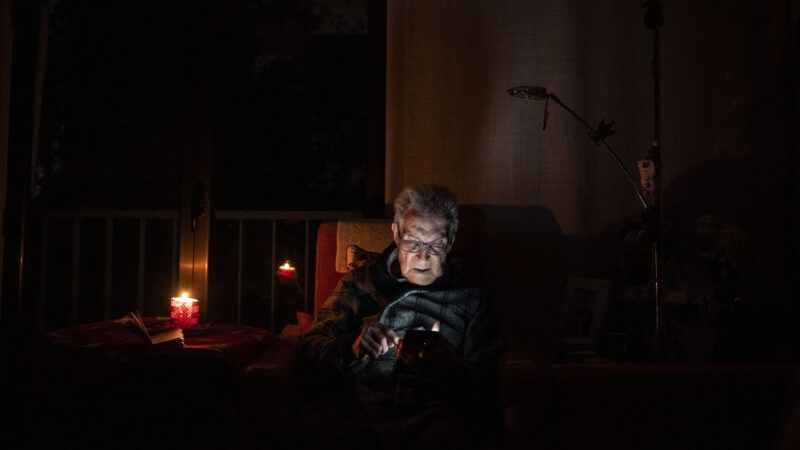Spain's Grid Collapsed in 5 Seconds. The U.S. Could Be Next.
A massive blackout in Spain shows what happens when energy policy ignores the physics of electricity.

Across Spain and Portugal, more than 50 million people recently experienced the largest blackout in modern European history. Thousands of commuters stood stranded on the concourses of Spain's transit system. In the span of five seconds, 60 percent of the country's electricity supply vanished. This wasn't caused by a storm or a cyberattack—just bad policy and the most underappreciated force in modern engineering giving way: inertia.
When a power plant trips offline or demand suddenly spikes, the power grid has no cushion; it must respond instantly or it unravels. That's where inertia comes in. In coal, gas, and nuclear plants, massive turbine rotors spin at thousands of rpm. Even when power is cut, they keep turning, releasing stored energy that slows frequency shifts and buys precious time—seconds to a minute—for backup to kick in. It's not backup power, it's breathing room. Like the flywheel on a Peloton, it keeps things steady even when input falters.
Once frequency drops too far, automatic protection kicks in. Plants shut down. Substations isolate. The grid severs its own limbs to survive. If imbalance spreads faster than recovery can respond, the collapse cascades. Entire regions go dark—not for lack of power, but lack of time. Even the right answer, a minute late, is no answer at all.
That's what happened in Spain. On April 28, solar energy was generating nearly 18 gigawatts of electricity—more than half of the national demand. Within an hour, more than two-thirds of it disappeared due to what authorities called a "technical fluctuation." Grid frequency plummeted. France tried to send emergency power across the intertie, but the imbalance tripped the connection. In five seconds, the entire Iberian grid collapsed.
Experts/government regulators are unsure if solar power alone caused the failure. But a system hell-bent on pushing renewables certainly ensured that the failure was catastrophic. This wasn't bad luck. It was bad policy made manifest—a sequence I've come to call the Four Horsemen of Grid Failure:
- Subsidized volatility. Between 2018 and 2024, Spain tripled its solar capacity, adding over 20 gigawatts in record time. The boom was fueled by E.U. Green Deal money, domestic tax credits, generous feed-in tariffs, and guaranteed priority access. Renewables didn't compete—they were legally first in line. By midday, solar routinely overwhelmed the grid, forcing other power plants offline. And when it disappeared, as it did that day, there was nothing steady underneath.
- Penalized reliability. In just two years, Spain shut down 15 coal plants—including Teruel and Compostilla II, which together delivered over 2,200 megawatts (MW) of inertia-rich baseload energy. Gas was throttled by greenhouse gas emissions penalties and pricing rules that made it barely worth running. Nuclear energy, once the quiet anchor of the system, was slated for full retirement by 2035. The plants that made the grid resilient weren't just sidelined. They were financially erased.
- Neglected backup. Spain bet on constant supply and perfect conditions with no grid-scale batteries, demand response, or new pumped hydroelectric power. When solar power collapsed and wind stalled, there was no fallback. Even the intertie with France failed under the strain. No margin for error.
- Regulatory arrogance—the fatal assumption that planners could schedule physics. Infrastructure was phased out on ideological timelines, not engineering ones. Models were trusted over operators, warnings were ignored, and the system was made brittle.
And all of it added up to the most dangerous thing a grid can carry: an inertia gap. And, when solar drops out en masse—as it did in April—there's nothing left spinning. The machines that used to smooth those shocks had already been shut down, sidelined, or priced out of existence.
Across the U.S., we're replaying the same mistakes. Texas, through the Electric Reliability Council of Texas (ERCOT), now gets more than 35 percent of its energy from wind and solar—spiking past 80 percent on the right day. But ERCOT is a grid on an island; it can't import help or borrow stability. In 2023, a sudden frequency dip pushed the system into emergency conditions. Massive grid-scale batteries kicked in just in time, averting disaster. But those batteries are expensive band-aids, not baseload. And as Texas pushes to retire more fossil fuel generation by 2030, the gap between supply and stability will only widen. California often hits 100 percent renewable energy during daylight hours, only to fall off a cliff at sundown. Gas plants have to scramble to catch the drop. To simulate the inertia it tore out, California's now installing massive flywheels to mimic the inertia that coal and nuclear used to provide by default.
The rest of the country looks more balanced, on paper at least. But PJM Interconnection—a regional transmission organization that manages the flow of wholesale electricity across 13 states—is set to lose up to 58 gigawatts of firm generation by 2030. With reliability at risk, it's now fast-tracking 11.8 gigawatts of new gas plants just to stay afloat. The Midcontinent Independent System Operator (MISO) isn't far behind. It plans to retire 25 gigawatts of coal and add 10 gigawatts of solar by decade's end. But its own projections show a 4.7 gigawatt shortfall in firm capacity by 2028. And, after shutting down Indian Point, New York is gambling on offshore wind and Canadian hydro to fill its 2,000-megawatt hole.
Stable power is retiring faster than its replacements can show up—stuck in queues, lawsuits, or supply chain hell. We've spent a decade subsidizing volatility, penalizing reliability, and crossing our fingers that storage will arrive on time. Meanwhile, the slow, steady, heavy machines that actually hold the grid together are being dismantled.
Spain's blackout wasn't just a technical failure. It was a political one. A preview of what happens when the Four Horsemen ride unchecked. Because when the turbines stop spinning, it's not just the lights that go out. It's the whole illusion.
